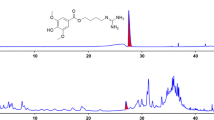Abstract
Because of decreased estrogen levels, postmenopausal women are at a high risk of developing dyslipidemia, obesity, and other metabolic diseases. The effects of Korean ginseng were investigated to determine whether it can be used as an adjunct supplement for hyperlipidemia. Ovariectomized Sprague-Dawley rats were used to mimic postmenopausal conditions and were randomly divided into five groups (n=6): normal control, high-fat diet, high-fat diet+statin, high-fat diet+white ginseng, and high-fat diet + heated ginseng. In vitro results revealed that heated ginseng had higher ginsenosides. Meanwhile, in vivo results showed that heated ginseng inhibited excessive lipogenesis and promoted lipolysis. It also had a better lipid profile than white ginseng. Finally, plasma adipokine levels indicated a lower risk of developing obesity-induced hyperlipidemia in rats fed heated ginseng. Overall, these results suggest that heated ginseng ameliorates hyperlipidemia and that it can be a suitable alternative to white ginseng.
Similar content being viewed by others
References
Goldstein J, Hazzard WR, Schrott HG. Hyperlipidemia in coronary heart disease I. Lipid levels in 500 survivors of myocardial infarction. J. Clin. Invest. 52: 1533–1543 (1973)
Lemieux C, Picard F, Labrie F, Richard D, Deshaies Y. The estrogen antagonist EM-652 and dehydroepiandrosterone prevent diet-and ovariectomy-induced obesity. Obes. Res. 11: 477–490 (2003)
Shadoan MK, Anthony MS, Rankin SE, Clarkson TB, Wagner JD. Effects of tibolone and conjugated equine estrogens with or without medroxyprogesterone acetate on body composition and fasting carbohydrate measures in surgically postmenopausal monkeys. Metab. Clin. Exp. 52: 1085–1091 (2003)
Chapman MJ. Fibrates: Therapeutic action in atherogenic dyslipidemia and future perspectives. Atherosclerosis 171: 1–13 (2003)
Attele A, Wu JA, Yuan CS. Ginseng pharmacology. Biochem. Pharmacol. 58: 1685–1693 (1999)
Lim SI, Cho CW, Choi UK, Kim YC. Antioxidant activity and ginsenoside pattern of fermented white ginseng. J. Ginseng Res. 34: 168–174 (2010)
Wee JJ, Park KM, Chung AS. Biological activities of ginseng and its application to human health. pp. 157–174. In: Herbal Medicine. Biomolecular and Clinical Aspects. 2nd ed. CRC Press, Inc., Boca Raton, FL, USA (2011)
Huang KC. The Pharmacology of Chinese Herbs. 2nd ed. CRC Press, Inc., Boca Raton, FL, USA. pp. 17–51 (1999)
Lee LS, Cho CW, Hong HD, Lee YC, Choi UK, Kim YC. Hypolipidemic and antioxidant properties of phenolic compound-rich extracts from white ginseng (Panax ginseng) in cholesterol-fed rabbits. Molecules 18: 12548–12560 (2013)
Brekhman II. Panax Ginseng. Leningrad: Gosudarst Isdat Et Med. 2: 10–24 (1957)
Inoue M, Wu CZ, Dou DQ, Chen YJ, Ogihara Y. Lipoprotein lipase activation by red ginseng saponins in hyperlipidemia model animals. Phytomedicine 6: 257–265 (1999)
Kim SH, Park KS. Effects of panax ginseng on lipid metabolism in humans. Pharmacol. Res. 48: 511–513 (2003)
American Botanical Council. Ginseng root: Excerpt from herbal medicine: Expanded commission E monograph. Integrative Medicine Communications. Available from: http://cms.herbalgram.org/expandedE/Ginsengroot.html?ts=1430905837&signature=8ab1302a0ffd9f3c874db8f46554c9cc. Accessed June 15, 2015.
Hulcher FH, Olson WH. Simplified spectrophotometric assay for microsomal 3-hydroxy-3-methylglutaryl coareductase by measurement of coenzyme A. J. Lipid Res. 14: 625–631 (1973)
Beiber LL, Abraham T, Helmrath T. A rapid spectrophotometric assay for carnitinepalmitoyltransferase. Anal. Biochem. 50: 509–518 (1972).
Pitkänen E, Pitkänen O, Uotila L. Enzymatic determination of unbound Dmannose in serum. Eur. J. Clin. Chem. Clin. Biochem. 35: 761–766 (1997)
Gibson DM, Hubbard DD. Incorporation of malonylcoa into fatty acids by liver in starvation and alloxan-diabetes. Biochem. Bioph. Res. Co. 3: 531–535 (1960)
Ochoa S. Malic Dehydrogenase from pig heart. pp. 735–739. In: Methods in Enzymology. Colowick SP, Kaplan, NO (eds). Academic Press, Inc., New York, NY, USA (1955)
Lazarow PB. Assay of peroxisomal beta-oxidation of fatty acids. Method. Enzymol. 72: 315–319 (1981)
Choi KT. Botanical characteristics, pharmacological effects and medicinal components of Korean Panax ginseng C.A. Meyer. Acta. Pharm. Sinic. 9: 1109–1118 (2008)
Libby P. What have we learned about the biology of atherosclerosis? The role of inflammation. Am. J. Cardiol. 88: 3–6 (2001)
Yamamoto M, Kumagai A. Long term ginseng effects on hyperlipidemia in man with further study of its actions on atherogenesis and fatty liver rats. pp. 13-20. In: Proceedings of the 4th International Ginseng Symposium. September 18, Korean Ginseng & Tobacco Research Institute, Daejeon, Korea, Korean Society of Ginseng, Seoul, Korea (1984)
Song YB, An YR, Kim SJ, Park HW, Jung JW, Kyung JS, Hwang SY, Kim YS. Lipid metabolic effect of Korean red ginseng extract in mice fed on a high diet. J. Sci. Food Agr. 92: 388–396 (2012)
Burguera B, Hofbauer LC, Thomas T, Gori F, Evans GL, Khosla S, Riggs L, Turner RT. Leptin reduces ovariectomy-induced bone loss in rats. Endocrinology 142: 3546–3553 (2001)
Ilalminski MA, Marsh JB, Harrison II E. Differential effects of fish oil, safflower oil and palm oil on fatty acid oxidation and glycerolipid synthesis in rat Liver. J. Nutr. 121: 1551–1561 (1991)
Stefanovix-Racic M, Perdomo G, Mantell BS, Sipula IJ, Brown NF, O’ Doherty RM. A moderate increase in carnitinepalmitoyltransferase 1a activity is sufficient to substantially reduce hepatic triglyceride levels. Am. J. Physiol. 294: E969–E977 (2008)
Author information
Authors and Affiliations
Corresponding author
Rights and permissions
About this article
Cite this article
Chung, S.I., Lo, L.M.P., Lee, S.C. et al. Antihyperlipidemic effects of Korean ginseng in high-fat diet-fed ovariectomized rats. Food Sci Biotechnol 25, 1155–1161 (2016). https://doi.org/10.1007/s10068-016-0184-6
Received:
Revised:
Accepted:
Published:
Issue Date:
DOI: https://doi.org/10.1007/s10068-016-0184-6




